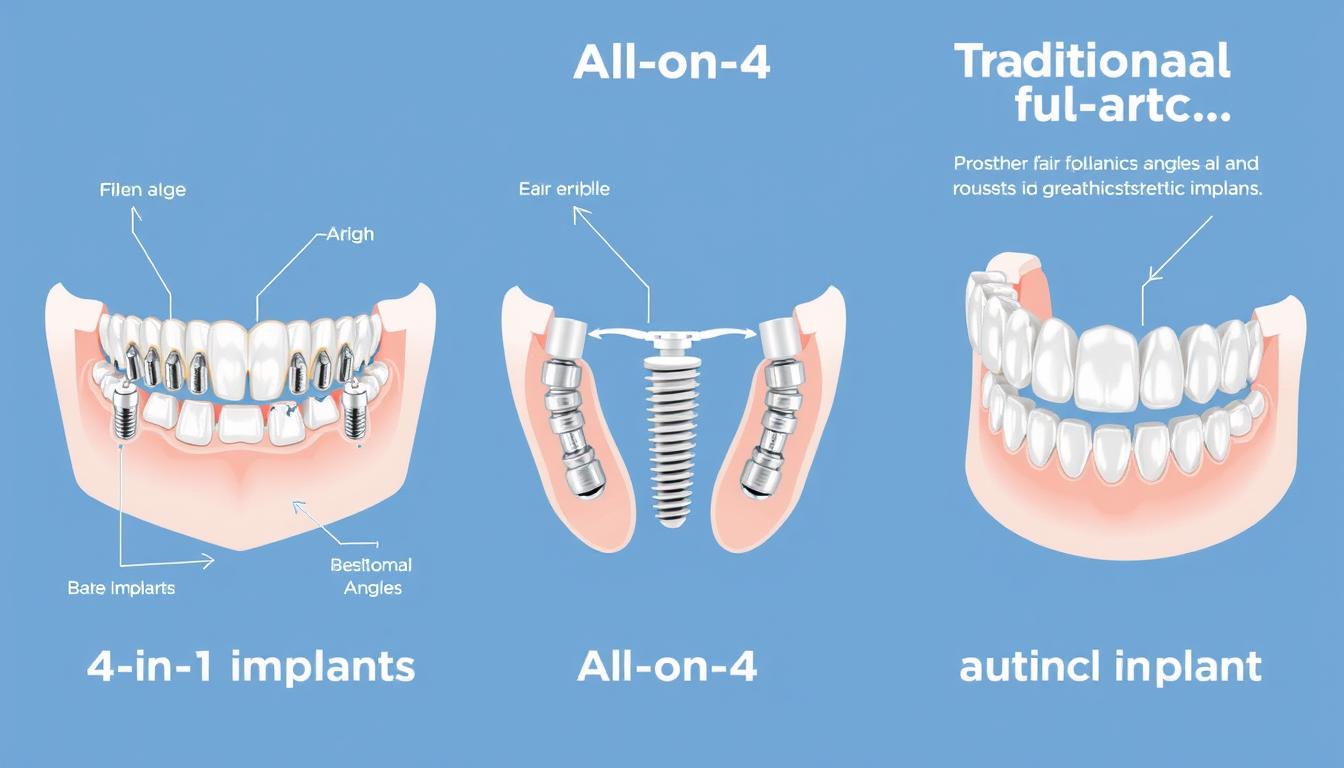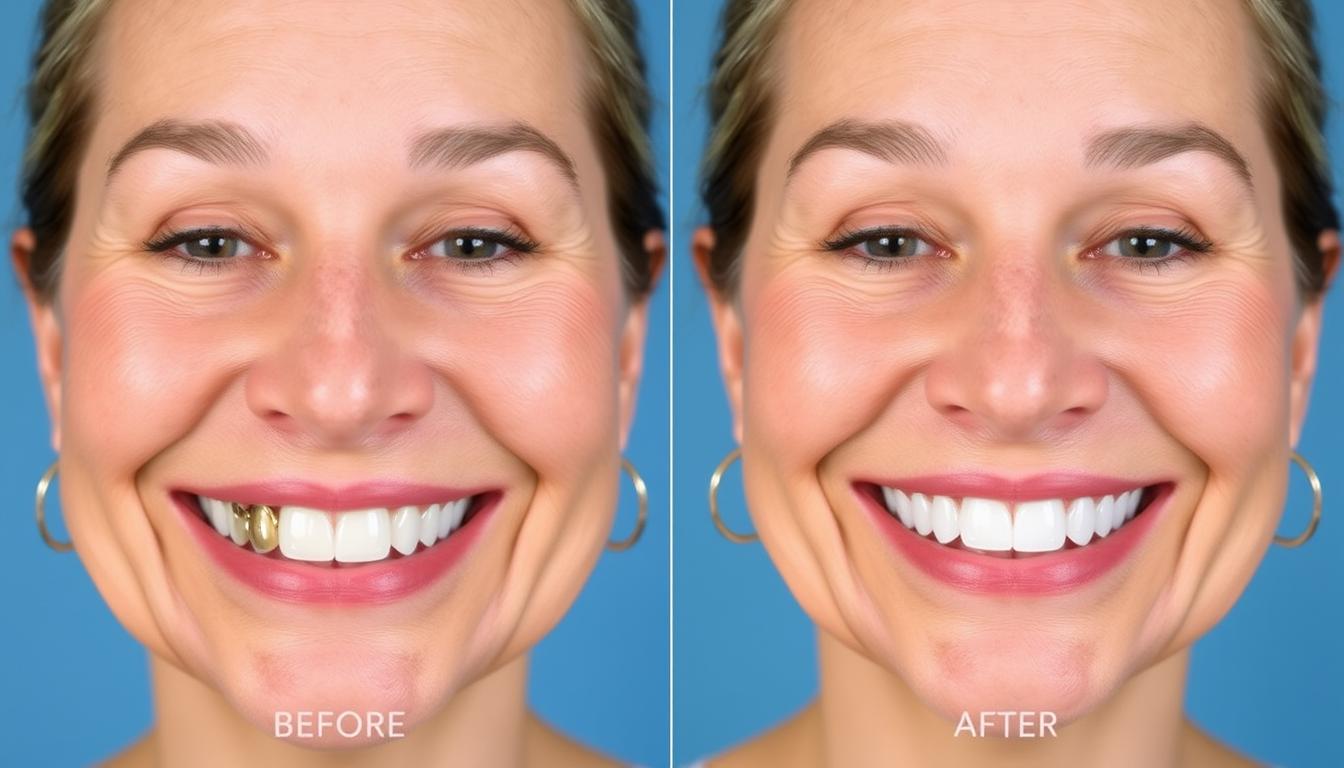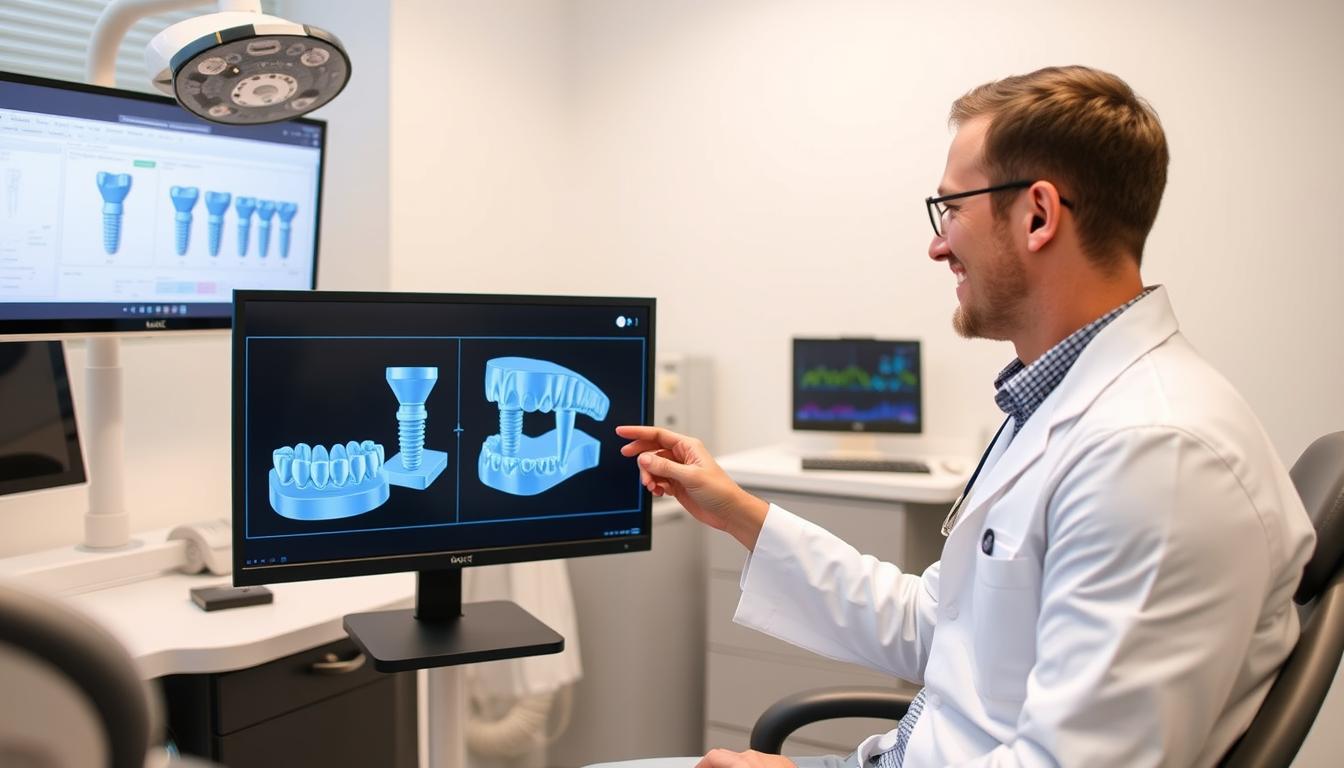Living with missing teeth or failing dental health can significantly impact your quality of life, affecting everything from your confidence to your ability to enjoy your favorite foods. If you’re considering a permanent solution for multiple missing teeth, 4-in-1 dental implants offer a revolutionary approach to full-arch restoration. This innovative technique provides a fixed, natural-looking smile with minimal recovery time and exceptional durability.
In this comprehensive guide, we’ll explore how 4-in-1 dental implants work, their benefits compared to traditional options, and everything you need to know before making this life-changing decision.
What Are 4-in-1 Dental Implants?

4-in-1 dental implants use four strategically placed implants to support an entire arch of teeth
4-in-1 dental implants (also known as “All-on-4” or “full arch implants”) represent an innovative approach to replacing an entire arch of missing teeth using just four dental implants. Unlike traditional methods that might require 6-8 implants per arch, this technique strategically places four implants to provide maximum support and stability for a full set of prosthetic teeth.
The key innovation of 4-in-1 dental implants lies in the angled placement of the posterior implants. While the two front implants are placed vertically, the two back implants are positioned at a 30-45 degree angle. This specialized technique maximizes contact with available bone and eliminates the need for bone grafting in many cases, making the procedure accessible to more patients.
How 4-in-1 Dental Implants Differ from Traditional Implants
Traditional Dental Implants
- Typically require one implant per missing tooth
- Often need extensive bone grafting
- Longer treatment timeline (6-12 months)
- Multiple surgical procedures
- Higher overall cost for full-arch restoration
4-in-1 Dental Implants
- Just four implants support an entire arch
- Angled placement often eliminates need for bone grafts
- Same-day teeth placement possible
- Single surgical procedure in most cases
- More cost-effective for full-arch restoration
The 4-in-1 approach represents a significant advancement in implant dentistry, offering a more efficient and less invasive solution for patients missing most or all of their teeth in one or both arches.
Key Benefits of 4-in-1 Dental Implants

Immediate Functionality
With the “teeth in a day” approach, you can receive your temporary fixed bridge on the same day as your implant surgery. This means you’ll never be without teeth during the healing process.
Cost-Effectiveness
By using just four implants instead of 6-8 traditional implants, the 4-in-1 technique significantly reduces the overall cost of full-arch restoration while maintaining excellent results.
Reduced Healing Time
The strategic placement of implants and elimination of bone grafting in many cases leads to faster healing and recovery compared to traditional implant methods.
Bone Preservation
Dental implants stimulate the jawbone, preventing the bone loss that typically occurs after tooth loss. The 4-in-1 technique effectively preserves bone structure with minimal invasiveness.
Improved Comfort
Unlike removable dentures, 4-in-1 implants are permanently fixed, eliminating discomfort, slippage, and the need for adhesives. They function just like natural teeth.
Enhanced Quality of Life
Patients report significant improvements in their ability to eat, speak, and smile with confidence. The fixed nature of the restoration provides stability and peace of mind.
Ready to Transform Your Smile?
Discover if 4-in-1 dental implants are right for you. Our specialists can evaluate your case and provide personalized recommendations.Schedule Free Consultation
The 4-in-1 Dental Implant Procedure: Step-by-Step

Understanding the 4-in-1 dental implant procedure can help alleviate concerns and set realistic expectations. Here’s what to expect throughout the treatment process:Initial Consultation and Assessment (1-2 visits)
Your journey begins with a comprehensive examination including digital 3D scans, X-rays, and a thorough evaluation of your oral health. Your dentist will assess bone density, discuss your goals, and determine if you’re a suitable candidate for 4-in-1 dental implants.Treatment Planning (1-2 weeks)
Using advanced imaging technology, your dental team will create a precise surgical plan for optimal implant placement. This digital planning ensures the most efficient use of available bone and perfect positioning for your new teeth.Pre-Treatment Procedures (if necessary)
Some patients may require tooth extractions or minor bone grafting before implant placement. These procedures can often be performed during the same surgical visit as the implant placement.Implant Surgery (1 day)
On the day of surgery, you’ll receive anesthesia for comfort. The dentist will place four titanium implants in strategic positions—two vertical implants in the front and two angled implants in the back of the jaw. This angled placement maximizes contact with available bone.Temporary Bridge Placement (Same day)
Immediately following implant placement, a temporary fixed bridge is attached to the implants. This provides you with functional, natural-looking teeth while your implants integrate with the jawbone.Healing and Osseointegration (3-6 months)
During this period, the implants fuse with your jawbone through a process called osseointegration. You’ll be able to eat soft foods and maintain a normal appearance while healing progresses.Final Prosthesis Design and Placement (2-3 visits)
Once healing is complete, your dentist will take impressions for your permanent prosthesis. The final bridge, typically made from high-quality zirconia or acrylic materials, is custom-designed for optimal aesthetics and function before being permanently attached to your implants.
Timeline Overview
| Stage | Timeframe | What Happens |
| Initial Consultation | 1-2 visits | Comprehensive examination and treatment planning |
| Implant Surgery | 1 day | Placement of four implants and temporary bridge |
| Initial Recovery | 1-2 weeks | Soft diet, initial healing of surgical sites |
| Osseointegration | 3-6 months | Implants fuse with jawbone, gradual return to normal diet |
| Final Prosthesis | 2-3 visits | Design and placement of permanent bridge |

Before and after: A patient’s transformation with 4-in-1 dental implants
Comparing Your Options: 4-in-1 vs. All-on-4 vs. Traditional Implants
Understanding the differences between various implant options can help you make an informed decision about your dental restoration. Here’s how 4-in-1 dental implants compare to other popular choices:
| Feature | 4-in-1 Dental Implants | All-on-4® Implants | Traditional Implants |
| Number of Implants | 4 implants per arch | 4 implants per arch | 6-8 implants per arch |
| Implant Placement | 2 vertical (front), 2 angled (back) | 2 vertical (front), 2 angled (back) | All vertical placement |
| Bone Grafting | Rarely needed | Rarely needed | Often required |
| Same-Day Teeth | Yes (temporary bridge) | Yes (temporary bridge) | No (3-6 month wait) |
| Treatment Time | 3-6 months total | 3-6 months total | 6-12 months total |
| Cost | $16,000-$28,000 per arch | $18,000-$30,000 per arch | $25,000-$40,000 per arch |
| Prosthesis Material | Zirconia or acrylic | Zirconia or acrylic | Various options |
Note: “4-in-1” and “All-on-4®” are often used interchangeably, with All-on-4® being a trademarked technique by Nobel Biocare. The core concept is the same—four implants supporting a full arch of teeth—but specific protocols may vary between providers.

Are You a Candidate for 4-in-1 Dental Implants?

While 4-in-1 dental implants offer a solution for many patients with missing teeth, not everyone is an ideal candidate. Understanding the requirements and potential limitations can help set realistic expectations.
Ideal Candidates
- Patients missing all or most teeth in one or both arches
- Those with adequate jawbone density (though less than required for traditional implants)
- Individuals seeking a fixed, permanent solution (not removable)
- Patients wanting to avoid extensive bone grafting procedures
- Those looking for a more cost-effective full-arch solution
- People with good overall health and controlled medical conditions
Potential Limitations
- Severe bone loss may require supplemental procedures
- Uncontrolled diabetes or other medical conditions
- Active gum disease (must be treated first)
- Heavy smoking (reduces success rates)
- Severe grinding or clenching habits
- Unrealistic expectations about results
Medical Considerations
Your dentist will evaluate your medical history thoroughly before recommending 4-in-1 dental implants. Certain conditions may require special consideration or preparation:
Conditions Requiring Evaluation
- Diabetes (should be well-controlled)
- Osteoporosis or bone density issues
- Autoimmune disorders
- History of radiation therapy to the head/neck
- Bleeding disorders
Preparation Recommendations
- Quit smoking at least 2 weeks before surgery
- Treat any existing gum disease
- Optimize blood sugar control for diabetics
- Discuss medication adjustments with your doctor
- Follow pre-surgical nutrition guidelines
Not sure if you qualify? Many patients who have been told they aren’t candidates for traditional implants may still qualify for 4-in-1 dental implants due to the specialized technique and angled placement. A consultation with a specialist is the best way to determine your eligibility.
Find Out If You’re a Candidate
Our specialists can evaluate your specific situation and determine if 4-in-1 dental implants are right for you.Request Your Evaluation
Addressing Common Concerns About 4-in-1 Dental Implants

Longevity and Durability
One of the most common questions about 4-in-1 dental implants concerns their lifespan. With proper care, the titanium implants themselves can last a lifetime, while the prosthetic bridge typically lasts 10-15 years before needing replacement. Factors affecting longevity include:
- Oral hygiene practices
- Regular dental check-ups
- Avoiding excessive force or trauma
- Material quality of the prosthesis
- Overall health factors
4.7
Average Patient Satisfaction
Comfort
4.7/5
Aesthetics
4.8/5
Function
4.6/5
Long-term Satisfaction
4.7/5
Maintenance Requirements
Maintaining 4-in-1 dental implants is straightforward but requires diligence. Here’s what you need to know about caring for your investment:
Daily Care
- Brush twice daily with a soft-bristle toothbrush
- Use a water flosser to clean under the bridge
- Utilize interdental brushes for hard-to-reach areas
- Rinse with antimicrobial mouthwash
Professional Maintenance
- Regular dental check-ups every 3-6 months
- Professional cleaning of the prosthesis
- Periodic evaluation of implant stability
- Prosthesis adjustment if needed

Cost Considerations
The investment in 4-in-1 dental implants typically ranges from $16,000 to $28,000 per arch, with several factors affecting the final cost:
- Geographic location and local market rates
- Dentist’s experience and specialization
- Need for additional procedures (extractions, bone grafting)
- Quality and material of the final prosthesis
- Type of anesthesia used
Financing Options: Many dental practices offer payment plans, financing options, or work with third-party financing companies to make treatment more accessible. Some dental insurance plans may provide partial coverage, though full coverage is rare for implant procedures.
Patient Experiences with 4-in-1 Dental Implants

“After years of struggling with failing teeth and uncomfortable dentures, my 4-in-1 dental implants have completely transformed my life. I can eat anything I want, smile with confidence, and I no longer worry about my teeth slipping. The procedure was much more comfortable than I expected, and the results have exceeded my expectations.”
— Michael R., 58
“I was told I wasn’t a candidate for traditional implants due to bone loss, but the 4-in-1 approach made it possible for me to have fixed teeth again. The ability to leave with temporary teeth the same day as surgery was amazing. It’s been two years now, and my implants feel just like natural teeth. Best decision I ever made.”
— Sarah T., 62
“I researched all my options for replacing my missing teeth and chose 4-in-1 implants for the value and efficiency. The recovery was much easier than I anticipated, and I was back to work within a week. The investment was significant but absolutely worth it for the quality of life improvement. I only wish I had done it sooner.”
— David L., 51

Real patient transformations with 4-in-1 dental implants
Frequently Asked Questions About 4-in-1 Dental Implants
How painful is the 4-in-1 dental implant procedure?
Most patients report that the procedure is much less uncomfortable than they anticipated. You’ll receive appropriate anesthesia during the surgery, which ensures you won’t feel pain during the procedure. Post-operative discomfort is typically manageable with prescribed pain medication and over-the-counter anti-inflammatories. Most patients describe the recovery as similar to that of tooth extractions, with the majority of discomfort subsiding within the first 48-72 hours.
How soon can I eat normally after getting 4-in-1 dental implants?
While you’ll receive temporary teeth the same day as surgery, you’ll need to follow a soft food diet for approximately 6-8 weeks to allow proper healing and osseointegration. Your dentist will provide specific dietary guidelines, but generally, you should avoid hard, crunchy, or chewy foods during this initial healing period. After your final prosthesis is placed and your implants have fully integrated, you can return to eating virtually any food you enjoy, with minimal restrictions.
How do 4-in-1 dental implants compare to removable dentures?
4-in-1 dental implants offer significant advantages over traditional removable dentures. They’re permanently fixed in your mouth (no removal for cleaning), provide superior stability and chewing function (30-40% more efficient), preserve jawbone health by preventing bone loss, and offer a more natural appearance and feel. While the initial investment is higher than dentures, many patients find the improved quality of life and long-term benefits well worth the cost difference.
Will insurance cover 4-in-1 dental implants?
Dental insurance coverage for implant procedures varies significantly between providers and plans. Most dental insurance plans provide limited coverage for implants, typically covering portions of the procedure or up to a maximum annual benefit. Medical insurance may provide some coverage if the tooth loss was due to an accident or medical condition. It’s important to verify your specific coverage with both your dental and medical insurance providers. Many dental practices also offer financing options to help make treatment more affordable.
How long do 4-in-1 dental implants last?
With proper care and maintenance, the titanium implants themselves can last a lifetime. The prosthetic bridge typically lasts 10-15 years before needing replacement due to normal wear and tear. Factors affecting longevity include oral hygiene practices, regular dental check-ups, avoiding excessive force or trauma, and overall health. Your dentist will monitor the condition of your implants and prosthesis during regular check-ups and advise when components may need repair or replacement.
Can I get 4-in-1 implants if I’ve been told I don’t have enough bone for traditional implants?
Yes, many patients who lack adequate bone for traditional implants can still be candidates for 4-in-1 dental implants. The angled placement technique utilized in 4-in-1 implants maximizes the use of available bone and often eliminates the need for extensive bone grafting. Additionally, the implants are strategically placed in areas of the jaw that typically have more bone density. However, a thorough evaluation by a qualified implant specialist is necessary to determine if you’re a suitable candidate based on your specific bone structure and oral health.
What material options are available for the final prosthesis?
The most common materials for 4-in-1 dental implant prostheses are zirconia and acrylic with a titanium framework. Zirconia offers superior strength, durability, and a natural appearance but comes at a higher cost. Acrylic with a titanium framework provides a good balance of aesthetics and function at a more moderate price point. Your dentist will discuss the advantages and considerations of each material option to help you make the best choice based on your needs, preferences, and budget. All-on-6 implants
Take the Next Step Toward Your New Smile

4-in-1 dental implants offer a life-changing solution for those struggling with missing teeth or uncomfortable dentures. With their innovative design, reduced healing time, and immediate functionality, they represent one of the most advanced options in modern dentistry for full-arch restoration.
The best way to determine if 4-in-1 dental implants are right for you is to schedule a consultation with a qualified implant specialist. During this appointment, you’ll receive a comprehensive evaluation, discuss your goals and concerns, and explore personalized treatment options.
What to Expect at Your Consultation
- Comprehensive oral examination
- Advanced 3D imaging to assess bone structure
- Discussion of your dental history and goals
- Personalized treatment recommendations
- Detailed cost and financing information
- Answers to all your questions and concerns
Request Your Free Consultation
Full NamePhone NumberEmail AddressYour Questions or ConcernsSubmit Request
We respect your privacy. Your information will never be shared.
Prefer to Speak with Someone Directly?
Our patient coordinators are ready to answer your questions and schedule your consultation.
Conclusion: Is a 4-in-1 Dental Implant Right for You?
4-in-1 dental implants represent a significant advancement in dental restoration technology, offering a more efficient, less invasive, and often more affordable solution for full-arch tooth replacement. With their ability to provide same-day teeth, reduced healing time, and excellent long-term results, they’ve become an increasingly popular choice for patients seeking to restore their smile and oral function.
While not every patient is an ideal candidate, the unique design of 4-in-1 implants makes this solution accessible to many who might not qualify for traditional implant approaches. The best way to determine if this innovative treatment is right for you is to consult with a qualified dental implant specialist who can evaluate your specific situation and provide personalized recommendations.
Whatever you decide, investing in your oral health and smile is one of the most impactful decisions you can make for your overall quality of life, confidence, and well-being.

1 thought on “4-in-1 Dental Implants: A Complete Guide to Full-Arch Restoration”